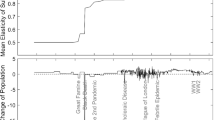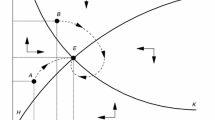Abstract
We build an overlapping-generations model that incorporates endogenous fertility choices, in addition to public and private expenditures on health. Following the seminal analysis of Bhattacharya and Qiao (J Econ Dyn Control 31:2519–2535, 2007) we assume that the effect of public health investment is complementary to private health expenditures. We find that this effect reinforces the positive impact of the capital stock on aggregate saving. Furthermore, we show that this complementarity can provide an additional explanation behind a salient feature of demographic transition; that is, the fertility decline along the process of economic growth.




Similar content being viewed by others
Notes
For empirical support on the negative relation between improved health status and fertility rates, see Finlay (2007).
This particular extension is not critical for the subsequent results. These remain similar even if individuals care only about old-age consumption.
Of course, the intuition differs as it will transpire in Section 5 where we provide the formal analysis.
For a similar assumption on health expenses being incurred during old adulthood, see Gutiérrez (2008).
We assume that \(\delta\bar{\varepsilon} < 1\) in order to ensure the concavity of h t + 1 with respect to x t + 1. A functional form that satisfies all these conditions is \(Z(p_{t+1}) = 1 + \frac{\varphi p_{t+1}}{1 + p_{t+1}}\) with \(\varphi = \bar{\varepsilon} - 1\).
The idea that public health spending contributes to some type of capital formation is intuitive once we think of spending on hospitals, medical equipment, support for medical research and training etc.
We can think of many examples that justify this assumption. The presence of qualified professionals—in the national health system—that offer support and advice on various difficulties that may emerge while people are trying to quit smoking (e.g., cravings etc.) may provide an incentive for smokers to seek and buy treatments that support Nicotine Replacement Therapy (patches, gums etc.). Clinical depression can be combated more effectively if sufferers combine antidepressant medication with appropriate counselling by qualified psychiatrists—counselling that is sometimes offered by professionals employed in the national health system. See Bhattacharya and Qiao (2007) for further examples in support of this conjecture.
Depending on different parameter values, n t can become less than one in the steady state. However, this possibility can be ruled out by an appropriate parameter restriction—particularly, if the parameter q is sufficiently low. Alternatively, rather than normalising the total endowed time to unity, we could have endowed young individuals with a larger time endowment—so large, to guarantee that fertility is always above one. Qualitatively, none of our results would be affected.
References
Becker GS, Murphy KM, Tamura R (1990) Human capital, fertility, and economic growth. J Polit Econ 98(5):12–37
Bhattacharya J, Qiao X (2007) Public and private expenditures on health in a growth model. J Econ Dyn Control 31(8):2519–2535
Blackburn K, Cipriani (2002) A model of longevity, fertility and growth. J Econ Dyn Control 26(2):187–204
Cigno A (1998) Fertility decisions when infant survival is endogenous. J Popul Econ 11(1):21–28
de la Croix D, Doepke M (2003) Inequality and growth: why differential fertility matters? Am Econ Rev 93(4):1091–1113
Ehrlich I, Lui F (1997) The problem of population and growth: a review of the literature from Malthus to contemporary models of endogenous population and endogenous growth. J Econ Dyn Control 21(1):205–242
Finlay J (2007) The role of health in economic development. PGDA working paper no. 21, Harvard University
Frankel M (1962) The production function in allocation and growth: a synthesis. Am Econ Rev 52(5):996–1022
Galor O (2012) The demographic transition: causes and consequences. Cliometrica 6(1):1–28
Galor O, Weil D (1996) The gender gap, fertility, and growth. Am Econ Rev 86(3):374–387
Galor O, Weil D (2000) Population, technology, and growth: from the Malthusian regime to the demographic transition and beyond. Am Econ Rev 90(4):806–828
Gutiérrez M (2008) Dynamic inefficiency in an overlapping generation economy with pollution and health costs. J Public Econ Theory 10(4):563–594
Kalemli-Ozcan S (2003) A stochastic model of mortality, fertility, and human capital investment. J Dev Econ 70(1):103–118
Kirk D (1996) Demographic transition theory. Popul Stud 50(3):361–387
Manuelli RE, Seshadri A (2009) Explaining international fertility differences. Q J Econ 124(2):771–807
Pitt MM, Rosenzweig MR, Nazmul Hassan M (1990) Productivity, health, and inequality in the intrahousehold distribution of food in low-income countries. Am Econ Rev 80(5):1139–1156
Romer P (1986) Increasing returns and long-run growth. J Polit Econ 94(5):1002–1037
Soares RR (2005) Mortality reductions, educational attainment, and fertility choice. Am Econ Rev 95(3):580–601
Strulik H (2008) Geography, health, and the pace of demo-economic development. J Dev Econ 86(1):61–75
Tamura R (1996) From decay to growth: a demographic transition to economic growth. J Econ Dyn Control 20(6–7):1237–1261
World Health Organisation (2010) World Health Statistics
Zhang J, Zhang J (2005) The effect of life expectancy on fertility, saving, schooling and economic growth: theory and evidence. Scand J Econ 107(1):45–66
Acknowledgements
We are grateful to two anonymous referees and an Editor of this journal for numerous comments and suggestions that have significantly improved the content and substance of our paper. Any remaining errors or omissions are solely our responsibility. Intan Zanariah Zakaria acknowledges financial support from the Malaysian Ministry of Higher Education and the International Isamic University of Malaysia. The usual disclaimer applies.
Author information
Authors and Affiliations
Corresponding author
Additional information
Responsible editor: Alessandro Cigno
Appendix
Appendix
1.1 Proof to Proposition 1
Using Eq. 18, we can define
We can also use Eqs. 6, 10 and 15 to write
From Eq. 36 we have
Alternatively, we can substitute Eq. 37 in Eq. 38 to write
From Eq. 36, we can also derive
to which we can substitute Eq. 37 to get
Substituting Eqs. 18 and 37 in Eq. 41, we can write the latter as
which is positive because \({Z}^{\prime}\left( {p_{t+1} } \right)p_{t+1} <Z\left( {p_{t+1} } \right)\) holds. Now, we can combine the results in Eqs. 42 and 38, and apply the implicit function theorem to Eq. 36. This yields
Therefore, given that q is a fixed parameter, we can conclude that \(n_t =n\left( {k_t } \right)\) such that \({n}'\left( {k_t } \right)<0\). Finally, we can use the previous analysis to write Eq. 17 as
from which it is straightforward to establish that ds t /dk t > 0. □
1.2 Proof to Proposition 2
From Eqs. 18 and 20, we can establish that \(n\left( 0 \right)=\frac{\gamma /q}{1+\beta \left( {1+\delta } \right)+\gamma }\) and \(n\left( \infty \right)=\frac{\gamma /q}{1+\beta \left( {1+\delta \bar{{\varepsilon }}} \right)+\gamma }\). Combining these with Eq. 22, we see that \(\psi \left( 0 \right)=0\) and \(\psi \left( \infty \right)=\infty \). Furthermore, it is
where
Clearly, ψ′(k t ) > 0. Now, combine Eqs. 39 and 42 to write Eq. 43 as
Given Z′(0) = ϕ and Z′( ∞ ) = 0, we can combine the expression above together with Eq. 37, \(n(0)=\frac{\gamma /q}{1+\beta (1+\delta )+\gamma }\) and \(n(\infty )=\frac{\gamma /q}{1+\beta (1+\delta \bar{{\varepsilon }})+\gamma }\) to establish that
Combining Eqs. 45 and 46 with Eq. 44, we infer that
Thus, we conclude that there must be at least one \(\hat{{k}}\in \left( {0,\infty } \right)\) such that \(\hat{{k}}=\psi (\hat{{k}})\) and \({\psi}^{\prime}(\hat{{k}})<1\), i.e. \(\hat{{k}}\) is a stable steady-state equilibrium. □
Rights and permissions
About this article
Cite this article
Varvarigos, D., Zakaria, I.Z. Endogenous fertility in a growth model with public and private health expenditures. J Popul Econ 26, 67–85 (2013). https://doi.org/10.1007/s00148-012-0412-1
Received:
Accepted:
Published:
Issue Date:
DOI: https://doi.org/10.1007/s00148-012-0412-1




